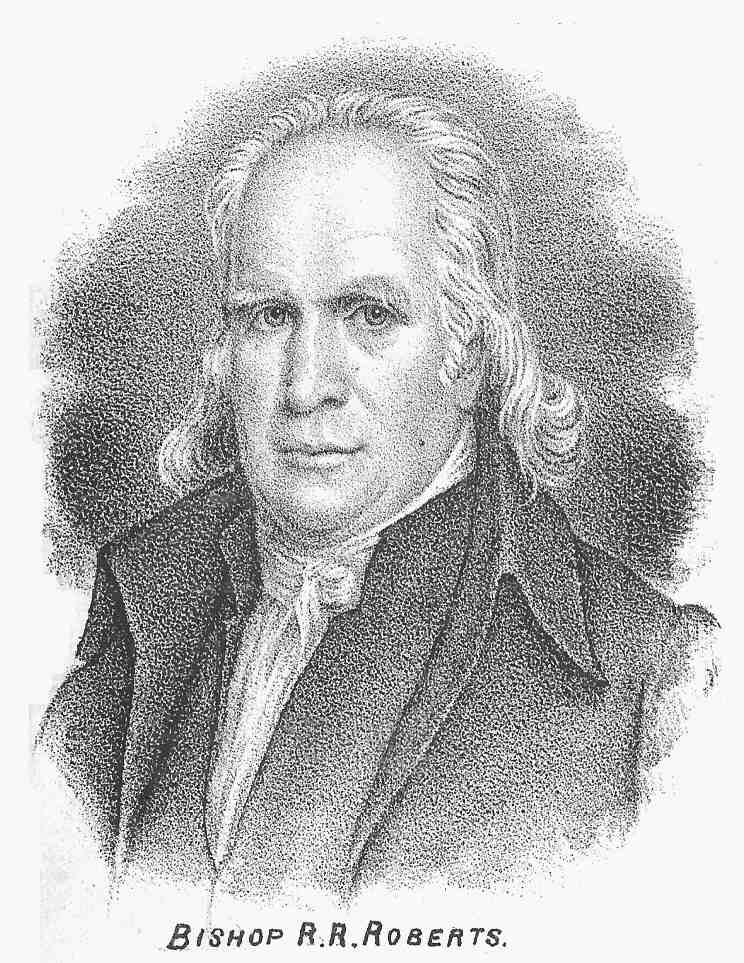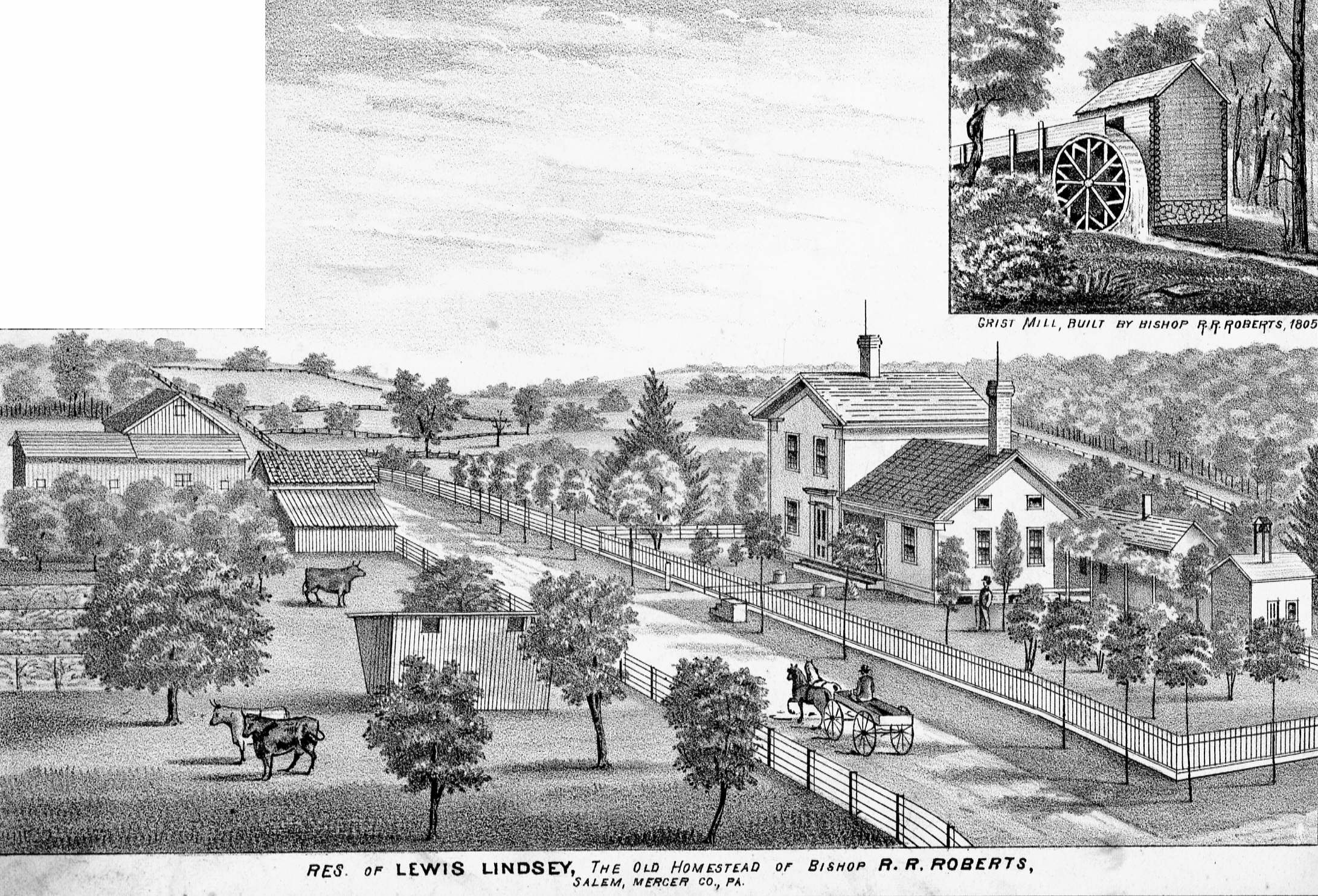Husband Bishop Robert R. Roberts 1

AKA: Richford Roberts 2
Born: 2 Aug 1778 - Frederick Co, MD 3
Christened:
Died: 26 Mar 1843 2
Buried:
Father: Robert M. Roberts ( - ) 2
Mother: Mary [Unk] ( - ) 2
Marriage: Feb 1799 - Ligonier, Westmoreland Co, PA 4

• Residence: : Salem, Mercer Co, PA. View of the residence of Bishop R. R. Roberts from the History of Mercer County, PA, 1877; pg. 63x
Wife Elizabeth Oldham 4
Born:
Christened:
Died:
Buried:
Children
General Notes: Husband - Bishop Robert R. Roberts
He was born Aug 21. [HWC 1882, 695]
The pioneer of Methodism in Mercer County, Pennsylvania, was, doubtless, Rev. R. R. Rob-erts, afterward well known as Bishop Roberts. He was born in Frederick County, Maryland, but in 1785 he removed with his father to Westmoreland County, Pennsylvania, where he continued to reside until the spring of 1796, when, at the age of eighteen, in company with his brother Thomas and three other young men of his neighborhood, he started to make his fortune in a yet newer country. The point finally reached was the tract lying north of what was later to be called Leech's Corners, where he began a settlement by erecting a log cabin. Mr. Roberts began to preach in 1801, and subsequently became famous in his church. In the year 1798 the parents of Mr. Roberts moved to the neighbor-hood in which he had settled. Mr. Roberts had been married in Ligonier to Miss Elizabeth Oldham, of York County. She, in company with her husband and Lewis Roberts, about two weeks after marriage, rode on horseback through the woods to their new home in the Shenango Valley. She was mounted on a good horse, with cooking utensils and a blanket strapped to her saddle. As they were going through a dense forest, her brother-in-law being ahead with the provisions, she and her husband were compelled to stop over night in the woods. Building a fire, they lay under their blankets, but were not permitted to sleep on account of the howling of the fierce wolves about them. Thus they spent the supperless night. [HMC 1888, 269]
In the spring of 1796 a party consisting of John Caughey, Robert Roberts and James Hubanks, intent upon securing homes in the new terri-tory of the northwest, which had been thrown open to settlement just four years before by the act of 1792, arrived in what is now the township of Salem, Mercer County, PA, from Westmoreland County. The party which thus arrived had set out on foot, carrying all their provisions and equipage on their backs. Each of the party had a gun, with the exception of Roberts. When the company left Westmore-land County it was larger by two than when it arrived in Salem Township. A brother of Robert Roberts, Thomas by name, and William McLean started on the expedition. As they reached a point on the Allegheny, afterward known as Freeport, their hearts failed them and they turned back. Thomas endeavored to induce his younger brother Robert, then only eighteen years of age, to return to the settlements with him, but the lad spiritedly declined, stating that he was not afraid of a little hardship. In Elliot's Life of Roberts, we find that on the third day after the return of Roberts and McLean, the remainder of the party, who had been pushing resolutely forward, reached what was known as the old Venango path, which they followed to its intersec-tion with French Creek. Here a short stop was made, and after a brief council they determined to follow the stream up to the mouth of the Cussawago (now Meadville). After they had arrived at the place they retraced their steps for a distance of eight miles, and then pushed off in a southwesterly direction until they arrived at the headwaters of the Little Shenango. Fol-lowing the custom of all early pioneers, as soon as they reached a suitable spot for location, they halted and built their cabins. Here they at once began clearings, commencing their operations by girdling the trees. After a brief time the provisions of the party were exhausted. Wild game, of course, was abundant, deer being especially so, but fresh meat became a monotonous diet when depended upon altogether. So the whole party walked to Meadville and packed their goods home on their backs. They purchased seed potatoes and corn, paying $3 per bushel for the former and $2 for the latter. These trips were repeated at different intervals. Upon one occasion young Roberts started back from Meadville with some sugar in his arms. It was on Sunday. A rain which fell dissolved it, leaving the party to do without their sweets. Roberts believed that the accident was a direct punishment from God for their wickedness in traveling on His holy day.
In the following June Roberts and Hubanks returned to Westmoreland County, leaving Caughey to look after their interests, and, in accordance with the act of 1792, to occupy their tracts and keep them free from intruding squatters. Caughey, however, was not destined to long remain alone in the township, for in the same spring a party, consisting of Stephen Riley, William Lindsay, Lewis and Thomas Roberts, from Ligonier, and Rev. Jacob Gurwell, entered and began settlements. Some accounts say that John Caughey had returned to the populous regions, and came back to his new land in company with the party. At any rate, the newcomers entered the region of Salem Township and prepared to secure land claims. The two Roberts brothers and Gurwell shortly afterward returned to the place whence they had come, intending to replenish their store of provisions, which had run low. They promised to be back in a short time. Weeks and months ensued, but they came not. Riley also returned home, and Lindsay was left to meet star-vation. He subsisted for an almost unendurable period on squirrels and other small game. But this proved so weakening that he was almost prostrated, when, upon looking out his cabin door, he beheld a party of whites approaching, which made his heart beat with joy. It comprised the Roberts family, includ-ing the father, three sons and one daughter, Elizabeth, the first woman ever in the territory. The newcomers brought abundant supplies, and also a few head of stock, with which to begin farming in earnest.
During the two following winters Robert, the future bishop, and his sister Elizabeth were left in the wilderness to guard the cabins, the remainder of the party having returned to Ligonier. It is related that during the long winter days, when there was nothing to do inside, Robert would take his rifle and depart on a hunting expedition into the surrounding forests, leaving his sister to pass the day alone. There was, fortunately, nothing to frighten her, as the few Indians who lived in the vicinity at the time were generally peaceful, and all had a high respect for the plucky woman. At night she used to take her station on the cabin roof, and by shouting at the top of her voice guide her brother in to his home. His answer to this signal was always a gunshot, which he fired to let her know he was coming. In the spring of 1798 Lind-say, Caughey and Robert Roberts settled permanently in the township, and became thereafter prominently identified with its history and development. Lindsay became Elizabeth's husband, while Caughey married her sister. [HMC 1888, 577]
In 1805, Bishop Roberts erected a grist-mill on a small stream known as Big Run.
General Notes: Wife - Elizabeth Oldham
from York Co, PA